Lara Croft GO – Review
by Mark R
|
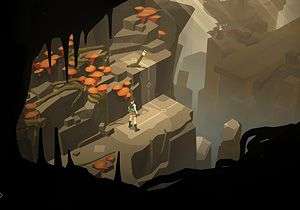 Back in 1991, those within the video game industry were trying to outdo each other in terms of graphics. With very limited scope available to them, they had to find new ways to push the envelope. Many did so using dithering to give the impression of more colours and shading, but Delphine Software pushed this envelope farther than anyone else by using simplicity to convey complexity. Their platformer, Another World, stripped graphics back as far as they could go, using filled polygons and genlocking tech to produce a sense of ultra-2D realism that has since been mimicked countless times. The most recent to fall on my lap is Square Enix’s Lara Croft GO – a highly stylised puzzler where it’s all about lateral thinking.
Back in 1991, those within the video game industry were trying to outdo each other in terms of graphics. With very limited scope available to them, they had to find new ways to push the envelope. Many did so using dithering to give the impression of more colours and shading, but Delphine Software pushed this envelope farther than anyone else by using simplicity to convey complexity. Their platformer, Another World, stripped graphics back as far as they could go, using filled polygons and genlocking tech to produce a sense of ultra-2D realism that has since been mimicked countless times. The most recent to fall on my lap is Square Enix’s Lara Croft GO – a highly stylised puzzler where it’s all about lateral thinking.
The aforementioned simplicity of the graphics serves to provide a perfect environment for your progression through rugged, creature-infested caverns on a quest for the ultimate prize – a fancy Rubik’s Cube. Although it is touted as a turn-based puzzler, it doesn’t follow the traditional route of having a number of moves play out before your turn ends to allow the enemies to shift their position. Instead, each singular move you make on the noded gameplay area is a trigger for the other cave-dwelling oddities to do the same, providing a constant flow of movement and a near real-time approach to the puzzle solving.
Obstacles in your way will take the form of giant snakes, komodo-sized salamanders, huge spiders, eroding environment, abandoned Stihl saws, and a creature not dissimilar to the ‘worms’ described in ancient legends. If the layout of the floor allows, you can kill any of these beasts by shooting them from the side or behind. Approach them from the front, however, and it’s insta-death for you. Picking up a flaming torch from a fire pit will allow you to move towards any of the foes, and they will back away from you, so it’s possible to use them to your advantage to trigger pressure pads while you work out which levers need pulled.
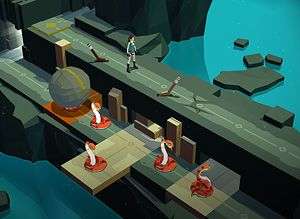 Yes, in true Lara Croft tradition, you’re not simply expected to traverse each area but also affect the lay of the land by moving pillars, raising or lowering designated floor sections using levers, and triggering traps and other twisted mechanisms through the means of pressure pads. Some of the most intriguing puzzles are those which feature a number of triggers, traps, creatures, and eroding tiles rather than simply avoiding dangerous foes. Luring a salamander from its post to follow you as an unwitting shield and take four darts to its back while you take the only available route across a trap can be very satisfying, especially when your next few moves may require the shifting of pillars to create a brand-new trap while being pursued by another angry beast.
Yes, in true Lara Croft tradition, you’re not simply expected to traverse each area but also affect the lay of the land by moving pillars, raising or lowering designated floor sections using levers, and triggering traps and other twisted mechanisms through the means of pressure pads. Some of the most intriguing puzzles are those which feature a number of triggers, traps, creatures, and eroding tiles rather than simply avoiding dangerous foes. Luring a salamander from its post to follow you as an unwitting shield and take four darts to its back while you take the only available route across a trap can be very satisfying, especially when your next few moves may require the shifting of pillars to create a brand-new trap while being pursued by another angry beast.
Dotted throughout each level are urns, some of which contain jewels while others have pieces of an ancient artifact. At the start of each new screen, your journal shows how many urns need to be found within that area, and it’s up to you to keep your eyes peeled for them. Initially, the best way to ensure a consistent haul is to look for any obvious urns before even making your first move and, in earlier levels, these will be very much out in the open. Those sneaky folk at Square Enix don’t want to make it easy for you, however, so some will be hidden under sliding areas which won’t be revealed until you’ve made changes to the environment and, typically, by that point you may too wrapped up in staying alive that you don’t actually notice it.
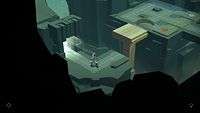 |
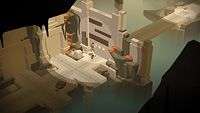 |
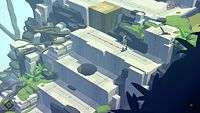 |
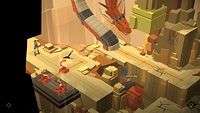 |
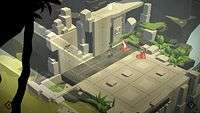 |
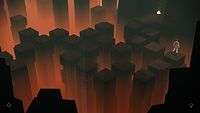 |
As you progress through caverns, these urns can be obscured to the point where only a few pixels are visible, or they’re in clear view but far enough away that the atmospheric perspective makes them so difficult to see that they’re easily missed until you reach the end of said level and wonder how the hell you managed to ignore three out of the four possible urns. The sense of satisfaction from picking up each of the urns, however, makes it worth your while to go back through your journal for any unfinished pick-ups.
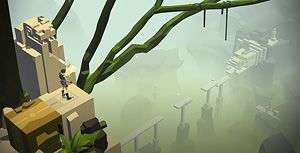 Perhaps the greatest challenge in Lara Croft GO is how it can, at times, fool you into thinking that you’re making some pretty smart moves until suddenly you’re killed by flying darts from a wall trap, triggered by a snake darting backwards in fear from your flaming torch. “How could I not see that coming?!” was uttered many times during my playthrough, and each time it was coupled with a wry smile as I attempted to re-trace my steps until the point where the bad decision was made.
Perhaps the greatest challenge in Lara Croft GO is how it can, at times, fool you into thinking that you’re making some pretty smart moves until suddenly you’re killed by flying darts from a wall trap, triggered by a snake darting backwards in fear from your flaming torch. “How could I not see that coming?!” was uttered many times during my playthrough, and each time it was coupled with a wry smile as I attempted to re-trace my steps until the point where the bad decision was made.
As is often the case with mobile-based games, there is an option to buy help in the form of a single in-app purchase. Doing so unlocks a feature where you simply tap a light-bulb icon and the puzzle restarts in an under-saturated manner with a series of linked red dots guiding you along the correct path. It doesn’t help with the collectibles, and is there solely to help you get through each puzzle intact. Concerned as to how this would work with so much back-tracking, triggering, and lever-pulling, I did the unthinkable and actually paid for it on impulse. It’s surprisingly intuitive, highlighting levers when they need pulled, triggers when they need pressure, and showing the direction in which pillars should be moved. I also admit to genuinely using it in one of the final levels where my tablet’s power was running out quicker than the power supply could provide it, and I was only a few screens from the end – blame the serpent.
Lara Croft GO is a fairly short game, probably around four to five hours in total – it’s hard to gauge as I didn’t play it through in a single sitting – but is a great departure from the norm. Having never played Hitman GO, I can’t honestly say how Lara stands up against Agent 47, but for a mobile game from a triple-A studio and an A-list character, the £3.99 price tag was certainly worth it. In terms of puzzle mechanics, I’d place it up there with my 2013 sleeper hit, Shardlands. The graphics are gorgeous, the atmosphere from the soundtrack sets the tone beautifully (very reminiscent of Brad Fidel, although I suspect that’s likely an insult to the composer), and the balance of difficulty it spot on. I’ve already started playing through those levels with missing urns, kicking myself when I see how obvious some are.
Pros- Beautifully stylised graphics
- Excellent level design
- Some genuine tension in certain areas
- Great use of the environment in places
- Very much in keeping with the Lara Croft design, especially in-menu
- Can really make you think in later levels
- Could benefit from a ghost to let you see your previous moves after you've been killed and thrown back to the start of a level
At only 50p shy of the cost of a Mocha from Starbucks, Lara Croft GO offers considerably more than a tepid drink. The puzzles do enough to make you think without ever reaching the point where you consider throwing your tablet through a window or feeding it to the dog. The way in which some screens can suddenly turn on you when you least expect it keeps you on your toes, mentally, and makes for a greatly rewarding experience overall.
Last five articles by Mark R
- From Acorns to Fish
- Alone In The Dark
- Why Borderlands is Better Than Borderlands 2
- Falling Short
- The Division: A Guide to Surviving the Dark Zone Solo


















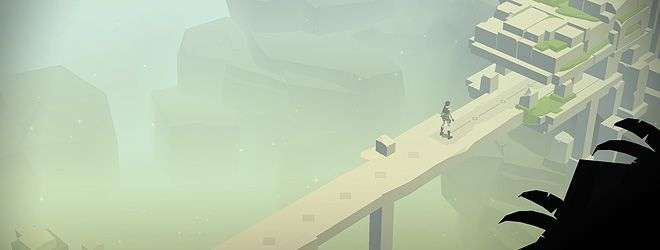
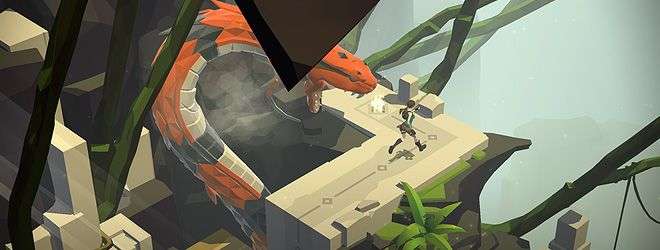






There are only 2 Lara Croft/Tomb Raider games I haven’t played (barring any PC add-ons) or don’t own that I am aware of and this is one of them. Always enjoyed the series. Maybe I’ll get this off the list someday.
I have now played it and loved it, how could I not; it’s Lara Croft and puzzles. If you still have it on your device and enjoyed it, check for an update as a second adventure was added.